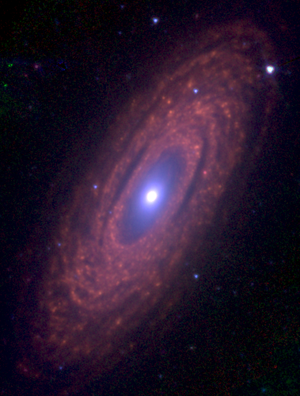NGC 2841
| NGC 2841 | |
|---|---|

Infrared image derived from data taken by the Spitzer Space Telescope.
|
|
| Observation data (J2000 epoch) | |
| Constellation | Ursa Major |
| Right ascension | 9h 22m 02.6s |
| Declination | +50° 58′ 35″ |
| Redshift | 638 ± 3 km/s |
| Apparent magnitude (V) | 10.1 |
| Characteristics | |
| Type | SA(r)b |
| Apparent size (V) | 8′.1 × 3′.5 |
| Other designations | |
| UGC 4966, PGC 26512 | |
Coordinates: ![]() 9h 22m 02.6s, +50° 58′ 35″
9h 22m 02.6s, +50° 58′ 35″
NGC 2841 is an inclined unbarred spiral galaxy exhibiting a prominent inner ring structure in the constellation Ursa Major, it was discovered on 9 March 1788 by William Herschel. Initially thought to be about 30 million light years distant, a 2001 Hubble Space Telescope survey of the galaxy's Cepheid variables determined that it was approximately 14.1 megaparsecs or 46 million light years distant.
NGC 2841 is a giant spiral galaxy with properties similar to those of the Andromeda Galaxy. It is a prototypical flocculent spiral galaxy, a type of spiral galaxy whose arms are patchy and discontinuous.
NGC 2841 is home to large population of young blue stars, and few H II regions.
NGC 2841 contains a low-ionization nuclear emission-line region (LINER), a type of region that is characterized by spectral line emission from weakly ionized atoms.
...
Wikipedia
